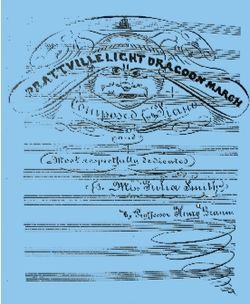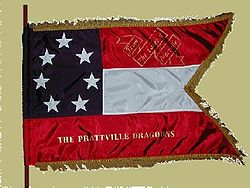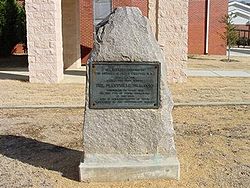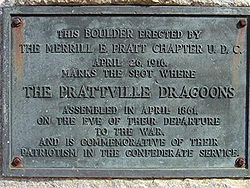
Prattville Dragoons
Encyclopedia

Company (military unit)
A company is a military unit, typically consisting of 80–225 soldiers and usually commanded by a Captain, Major or Commandant. Most companies are formed of three to five platoons although the exact number may vary by country, unit type, and structure...
of men from the city of Prattville
Prattville, Alabama
Prattville is a city in Autauga and Elmore counties in the U.S. state of Alabama. As of the 2010 Census, the population of the city is 33,960. Nicknamed "The Fountain City" due to the many artesian wells in the area, Prattville is part of the Montgomery metropolitan statistical area and serves as...
, and Autauga County, Alabama
Autauga County, Alabama
Autauga County is a county in the U.S. state of Alabama. As of the 2010 census the population was 54,571. Its county seat is Prattville.Autauga County is part of the Montgomery Metropolitan Statistical Area.-History:...
to form for service in the impending American Civil War
American Civil War
The American Civil War was a civil war fought in the United States of America. In response to the election of Abraham Lincoln as President of the United States, 11 southern slave states declared their secession from the United States and formed the Confederate States of America ; the other 25...
of 1861-1865. The idea for forming a Company was originally suggested by Samuel D. Oliver, from nearby Robinson Springs, Alabama. The Company organized on December 8, 1860 in the west front parlor of the home of George L. Smith, (now the Prattaugian Museum.) The Company was formed as a part of the "Alabama Volunteer Corps" and in her book Hon. Daniel Pratt, Mrs. S.F.H. Tarrant states that "... Mr. Pratt presented to every member of this cavalry company a uniform, made of black broadcloth, trimmed with gold braid. No other company in the State had a uniform so handsome." Mrs. Tarrant was a daughter of Gardner Cole Hale, Daniel Pratt's supervisor of the mill which made the Confederate Uniforms. He was recruited in 1848 from Fall River, Ma. to supervise Daniel Pratt's mill, using the cotton gin to gin the cotton right there next to the cotton fields, rather than sending it back to the textile mills in Ma. His son-in-law, Tarrant, was a member of the Prattville Dragoons, and injured in battle. To the amazement of the African-American freedmen in the on-looking Yankee troops, his valet laid out his cape and carried his master off the battlefield. Boss Hale, as his father-in-law was called, left a son back in Medfield, Ma who served in the G.A.R., and was truly torn when the Civil War started 17 years after his emigration from Manfield, Ma., a war between brothers.
In his book War History of the Prattville Dragoons Captain W.F. Mims (the last Commander of Co. H, 3rd Ala. Cav., CSA) spoke fondly of Pratt
Daniel Pratt
Daniel Pratt pioneered ventures that opened the door for industry in the U.S. state of Alabama. Prattville in Autauga County and Birmingham's Pratt City in Jefferson County are both named for him...
's generosity, stating, "Many not being able to furnish their mounts were greatly discouraged. That great and good man, Daniel Pratt, so well known for deeds of charity and generosity, supplied the defeiciency at a cost of many hundred dollars." (Quoting Historian Tommy Brown of the Continental / Eagle Manufacturing Company - still producing cotton gins in Daniel Pratt's buildings - "Daniel Pratt was Alabama's first millionaire.") The rank of "Captain" was voted by the members of the Unit, and the first Captain of the Prattville Dragoons was Jesse Cox "of Steamboat notoriety" from Mobile, Alabama. In total, there was originally "18 commissioned and non-commissioned officers and 82 privates, total 100, with two faithful colored cooks." The soldiers formed for their send-off at the school yard of the Prattville Academy and was presented a beautiful silk flag that was sewn by hand by the young ladies of Prattville. On Confederate Memorial Day
Confederate Memorial Day
Confederate Memorial Day, also known as Confederate Decoration Day and Confederate Heroes Day , is an official holiday and/or observance day in parts of the U.S. South as a day to honor those who died fighting for the Confederate States of America during the American Civil War...
in 1916, a large boulder with a bronze plaque was placed on that site to honor the Dragoons by the United Daughters of the Confederacy
United Daughters of the Confederacy
The United Daughters of the Confederacy is a women's heritage association dedicated to honoring the memory of those who served in the military and died in service to the Confederate States of America . UDC began as the National Association of the Daughters of the Confederacy, organized in 1894 by...
.

Montgomery, Alabama
Montgomery is the capital of the U.S. state of Alabama, and is the county seat of Montgomery County. It is located on the Alabama River southeast of the center of the state, in the Gulf Coastal Plain. As of the 2010 census, Montgomery had a population of 205,764 making it the second-largest city...
, and then partially by train, and partially by horseback to Pensacola, Florida
Pensacola, Florida
Pensacola is the westernmost city in the Florida Panhandle and the county seat of Escambia County, Florida, United States of America. As of the 2000 census, the city had a total population of 56,255 and as of 2009, the estimated population was 53,752...
to the Camp of Instruction there being led by General Braxton Bragg
Braxton Bragg
Braxton Bragg was a career United States Army officer, and then a general in the Confederate States Army—a principal commander in the Western Theater of the American Civil War and later the military adviser to Confederate President Jefferson Davis.Bragg, a native of North Carolina, was...
. The majority of the Prattville Dragoons brought their personal civilian and hunting firearms with them, but those lacking arms were issued Colt 1851 Navy Revolver
Colt 1851 Navy Revolver
The Colt Revolving Belt Pistol of Naval Caliber , later known as the Colt 1851 Navy or Navy Revolver, is a cap and ball revolver. It was designed by Samuel Colt between 1847 and 1850. It remained in production until 1873, when revolvers using fixed metallic cartridges came into widespread use...
s and sabers. While in Pensacola, the Prattville Dragoons were first assigned as the "mounted" Company "I" of the 7th Alabama Infantry. They left Pensacola in February 1862 traveling light and suffered through snow, sleet and rain in Chattanooga, Tennessee
Chattanooga, Tennessee
Chattanooga is the fourth-largest city in the US state of Tennessee , with a population of 169,887. It is the seat of Hamilton County...
that March. They marched further and participated in the Battle of Shiloh
Battle of Shiloh
The Battle of Shiloh, also known as the Battle of Pittsburg Landing, was a major battle in the Western Theater of the American Civil War, fought April 6–7, 1862, in southwestern Tennessee. A Union army under Maj. Gen. Ulysses S. Grant had moved via the Tennessee River deep into Tennessee and...
in April 1862. When their initial term of enlistment expired, the Unit en masse reenlisted and was accepted as Company "H" of the 3rd Alabama Cavalry in Tupelo, Mississippi
Tupelo, Mississippi
Tupelo is the largest city in and the county seat of Lee County, Mississippi, United States. It is the seventh largest city in the state of Mississippi, smaller than Meridian, and larger than Greenville. As of the 2000 United States Census, the city's population was 34,211...
in June 1862. Captain Cox returned to the steamboat business, and Wilbur Fisk Mims was voted into the Captain position. As a Company of the Third Alabama Cavalry, the Prattville Dragoons accompanied the Confederate
Confederate States Army
The Confederate States Army was the army of the Confederate States of America while the Confederacy existed during the American Civil War. On February 8, 1861, delegates from the seven Deep South states which had already declared their secession from the United States of America adopted the...
Army of Tennessee
Army of Tennessee
The Army of Tennessee was the principal Confederate army operating between the Appalachian Mountains and the Mississippi River during the American Civil War. It was formed in late 1862 and fought until the end of the war in 1865, participating in most of the significant battles in the Western Theater...
into Kentucky and were engaged in daily conflicts with the enemy, particularly at Bramlet's Station and the Battle of Perryville
Battle of Perryville
The Battle of Perryville, also known as the Battle of Chaplin Hills, was fought on October 8, 1862, in the Chaplin Hills west of Perryville, Kentucky, as the culmination of the Confederate Heartland Offensive during the American Civil War. Confederate Gen. Braxton Bragg's Army of Mississippi won a...
. It fell back with the army, and was on constant and arduous duty during the remainder of the war, protecting its communications, guarding its rear and flanks, and often raiding upon the enemy's trains and outposts. The whole regiment was a part of the brigade composed of the First, Third, Fourth, Ninth, Twelfth, and Fifty-First Alabama Cavalry, commanded first by Gen. Allen of Montgomery, then subsequently by Gen. Hagan of Mobile.

Battle of Stones River
The Battle of Stones River or Second Battle of Murfreesboro , was fought from December 31, 1862, to January 2, 1863, in Middle Tennessee, as the culmination of the Stones River Campaign in the Western Theater of the American Civil War...
; Shelbyville
Shelbyville, Tennessee
Shelbyville is a city in Bedford County, Tennessee, United States. It had a local population of 16,105 residents at the 2000 census. Shelbyville, the county seat of Bedford County, was laid out in 1810 and incorporated in 1819...
; Chickamauga
Battle of Chickamauga
The Battle of Chickamauga, fought September 19–20, 1863, marked the end of a Union offensive in southeastern Tennessee and northwestern Georgia called the Chickamauga Campaign...
; Kingston
Kingston, Tennessee
Kingston is a city in and the county seat of Roane County, Tennessee, United States, and is adjacent to Watts Bar Lake. Kingston, with a population of 5,264 at the 2000 United States census, is included in the Harriman, Tennessee Micropolitan Statistical Area....
; Knoxville
Knoxville Campaign
The Knoxville Campaign was a series of American Civil War battles and maneuvers in East Tennessee during the fall of 1863. Union forces under Maj. Gen. Ambrose Burnside occupied Knoxville, Tennessee, and Confederate forces under Lt. Gen. James Longstreet were detached from Gen...
; Mossy Creek
Battle of Mossy Creek
The Battle of Mossy Creek was a minor battle of the American Civil War, occurring on December 29, 1863, in Jefferson County, Tennessee.Union Brig. Gen. Samuel D...
; Strawberry Plains
Strawberry Plains, Tennessee
Strawberry Plains is an unincorporated community straddling the boundary between Jefferson and Sevier and Knox counties in the U.S. state of Tennessee. The United States Geographic Names System classifies Strawberry Plains as a populated place....
; ... losing continuously in casualties, and suffering severely during General James Longstreet
James Longstreet
James Longstreet was one of the foremost Confederate generals of the American Civil War and the principal subordinate to General Robert E. Lee, who called him his "Old War Horse." He served under Lee as a corps commander for many of the famous battles fought by the Army of Northern Virginia in the...
's winter campaign. As the 3rd and her Company's fought in Dalton
Dalton, Georgia
Dalton is a city in Whitfield County, Georgia, United States. It is the county seat of Whitfield County and the principal city of the Dalton, Georgia Metropolitan Statistical Area, which encompasses all of both Murray and Whitfield counties. As of the 2010 census, the city had a population of 33,128...
and Atlanta
Atlanta Campaign
The Atlanta Campaign was a series of battles fought in the Western Theater of the American Civil War throughout northwest Georgia and the area around Atlanta during the summer of 1864. Union Maj. Gen. William T. Sherman invaded Georgia from the vicinity of Chattanooga, Tennessee, beginning in May...
it performed arduous service, fighting with severe loss at Decatur
Battle of Decatur
The Battle of Decatur was a demonstration conducted from October 26 to October 29, 1864, as part of the Franklin-Nashville Campaign of the American Civil War. Union forces of 3–5,000 men under Brig. Gen. Robert S. Granger prevented the 39,000 men of the Confederate Army of Tennessee under ...
, and helping to capture General Stoneman
George Stoneman
George Stoneman, Jr. was a career United States Army officer, a Union cavalry general in the American Civil War, and the 15th Governor of California between 1883 and 1887.-Early life:...
's column. In front of General William T. Sherman
William Tecumseh Sherman
William Tecumseh Sherman was an American soldier, businessman, educator and author. He served as a General in the Union Army during the American Civil War , for which he received recognition for his outstanding command of military strategy as well as criticism for the harshness of the "scorched...
, the regiment shrouded General Hood
John Bell Hood
John Bell Hood was a Confederate general during the American Civil War. Hood had a reputation for bravery and aggressiveness that sometimes bordered on recklessness...
's movements, then harassed the former on his march, participating in the fights near Macon
Macon, Georgia
Macon is a city located in central Georgia, US. Founded at the fall line of the Ocmulgee River, it is part of the Macon metropolitan area, and the county seat of Bibb County. A small portion of the city extends into Jones County. Macon is the biggest city in central Georgia...
; at Winchester; Aiken
Aiken, South Carolina
Aiken is a city in and the county seat of Aiken County, South Carolina, United States. With Augusta, Georgia, it is one of the two largest cities of the Central Savannah River Area. It is part of the Augusta-Richmond County Metropolitan Statistical Area. Aiken is home to the University of South...
; Fayetteville, Monroe's Crossroads
Battle of Monroe's Crossroads
-References:* Eicher, John H., and David J. Eicher, Civil War High Commands. Stanford: Stanford University Press, 2001. ISBN 0-8047-3641-3.* * *...
(where Confederate and Union troops engaged in the last cavalry battle of the Civil War); the Bentonville
Battle of Bentonville
At 3 p.m., Confederate infantry from the Army of Tennessee launched an attack and drove the Union left flank back in confusion, nearly capturing Carlin in the process and overrunning the XIV Corps field hospital. Confederates under Maj. Gen. D.H. Hill filled the vacuum left by the retreating...
; Raleigh
Raleigh, North Carolina
Raleigh is the capital and the second largest city in the state of North Carolina as well as the seat of Wake County. Raleigh is known as the "City of Oaks" for its many oak trees. According to the U.S. Census Bureau, the city's 2010 population was 403,892, over an area of , making Raleigh...
and Chapel Hill
Chapel Hill, North Carolina
Chapel Hill is a town in Orange County, North Carolina, United States and the home of the University of North Carolina at Chapel Hill and UNC Health Care...
. Reduced by its losses to a skeleton, the regiment was surrendered in North Carolina
North Carolina
North Carolina is a state located in the southeastern United States. The state borders South Carolina and Georgia to the south, Tennessee to the west and Virginia to the north. North Carolina contains 100 counties. Its capital is Raleigh, and its largest city is Charlotte...
as a part of General Joseph E. Johnston
Joseph E. Johnston
Joseph Eggleston Johnston was a career U.S. Army officer, serving with distinction in the Mexican-American War and Seminole Wars, and was also one of the most senior general officers in the Confederate States Army during the American Civil War...
's surrender on April 26, 1865. The Prattville Dragoons encamped to await Union parole, but after remaining dormant for several days without any sign of Union Officers to officially parole them, the Unit disbanded and returned to their homes.



